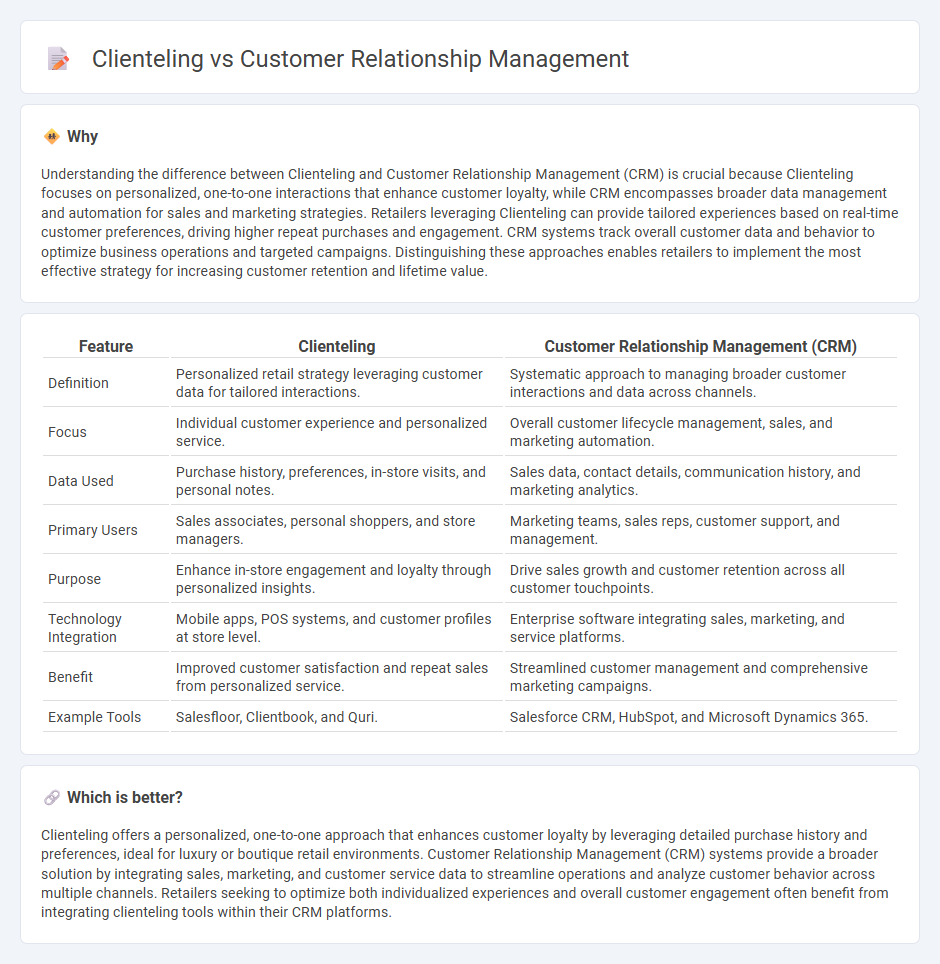
Clienteling focuses on personalized interactions and tailored experiences, leveraging detailed customer data to enhance loyalty and increase sales in retail environments. Customer Relationship Management (CRM) systems provide a broader approach by managing customer data across multiple channels to improve overall service and marketing strategies. Discover how combining clienteling with CRM can transform retail customer engagement and drive growth.
Why it is important
Understanding the difference between Clienteling and Customer Relationship Management (CRM) is crucial because Clienteling focuses on personalized, one-to-one interactions that enhance customer loyalty, while CRM encompasses broader data management and automation for sales and marketing strategies. Retailers leveraging Clienteling can provide tailored experiences based on real-time customer preferences, driving higher repeat purchases and engagement. CRM systems track overall customer data and behavior to optimize business operations and targeted campaigns. Distinguishing these approaches enables retailers to implement the most effective strategy for increasing customer retention and lifetime value.
Comparison Table
| Feature | Clienteling | Customer Relationship Management (CRM) |
|---|---|---|
| Definition | Personalized retail strategy leveraging customer data for tailored interactions. | Systematic approach to managing broader customer interactions and data across channels. |
| Focus | Individual customer experience and personalized service. | Overall customer lifecycle management, sales, and marketing automation. |
| Data Used | Purchase history, preferences, in-store visits, and personal notes. | Sales data, contact details, communication history, and marketing analytics. |
| Primary Users | Sales associates, personal shoppers, and store managers. | Marketing teams, sales reps, customer support, and management. |
| Purpose | Enhance in-store engagement and loyalty through personalized insights. | Drive sales growth and customer retention across all customer touchpoints. |
| Technology Integration | Mobile apps, POS systems, and customer profiles at store level. | Enterprise software integrating sales, marketing, and service platforms. |
| Benefit | Improved customer satisfaction and repeat sales from personalized service. | Streamlined customer management and comprehensive marketing campaigns. |
| Example Tools | Salesfloor, Clientbook, and Quri. | Salesforce CRM, HubSpot, and Microsoft Dynamics 365. |
Which is better?
Clienteling offers a personalized, one-to-one approach that enhances customer loyalty by leveraging detailed purchase history and preferences, ideal for luxury or boutique retail environments. Customer Relationship Management (CRM) systems provide a broader solution by integrating sales, marketing, and customer service data to streamline operations and analyze customer behavior across multiple channels. Retailers seeking to optimize both individualized experiences and overall customer engagement often benefit from integrating clienteling tools within their CRM platforms.
Connection
Clienteling and Customer Relationship Management (CRM) are interconnected through their shared focus on enhancing personalized customer experiences and fostering long-term loyalty in retail. Clienteling utilizes CRM data to tailor communications, recommend products, and deliver customized service based on individual customer preferences and purchase history. Effective integration of clienteling strategies and CRM systems drives increased customer satisfaction, repeat purchases, and higher lifetime value.
Key Terms
Personalization
Customer Relationship Management (CRM) systems centralize customer data to streamline marketing, sales, and service processes, enhancing overall business efficiency. Clienteling tools leverage this data to create personalized shopping experiences, enabling sales associates to offer tailored recommendations and build stronger customer connections. Discover how integrating CRM with clienteling can elevate personalization and drive customer loyalty.
Customer Data
Customer Relationship Management (CRM) centralizes customer data to analyze purchasing behavior, preferences, and interaction history, enabling targeted marketing and efficient service across multiple channels. Clienteling uses detailed customer profiles within CRM systems to personalize in-store experiences and foster loyalty through tailored recommendations and one-on-one communications. Explore how integrating CRM and clienteling strategies can transform customer engagement and increase retention.
Loyalty Programs
Customer Relationship Management (CRM) systems aggregate and analyze customer data to enhance broad loyalty program strategies, optimizing marketing campaigns and customer retention efforts. Clienteling employs personalized interactions using detailed purchase histories to tailor loyalty rewards and offers, fostering deeper one-on-one customer connections. Explore the distinct advantages of CRM and clienteling techniques to maximize your loyalty program's effectiveness.
Source and External Links
What is CRM (Customer Relationship Management)? - TechTarget - CRM is the combination of practices, strategies and technologies companies use to manage and analyze customer interactions and data across multiple channels to improve service, retention, and sales growth, involving operational, analytical, and collaborative CRM types.
What is Customer Relationship Management (CRM)? - Talkdesk - CRM is a proactive approach to managing customer data, communication, and support processes to enhance satisfaction and retention by delivering personalized, data-driven customer service.
Customer relationship management - Wikipedia - CRM is a strategic process to manage and improve customer relationships through marketing, relational intelligence, and assessing relationship profitability over different phases.
 dowidth.com
dowidth.com